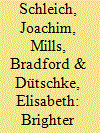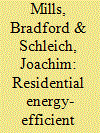| Srl | Item |
| 1 |
ID:
132595


|
|
|
|
|
| Publication |
2014.
|
| Summary/Abstract |
This paper quantifies the direct rebound effects associated with the switch from incandescent lamps (ILs) or halogen bulbs to more energy efficient compact fluorescent lamps (CFLs) or light emitting diodes (LEDs) using a large nationally representative survey of German households. The direct rebound effect is measured as the elasticity of energy demand for lighting with respect to changes in energy efficient lamps. In particular, the rebound effect is decomposed into changes in lamp luminosity and burn time. For the average bulb, the associated total direct rebound effect is estimated at about 6%. The larger part (around 60%) of this rebound effect results from increases in bulb luminosity. For the most frequent (modal) bulb switch, i.e. the replacement of the main bulb in the living or dining room, the total direct rebound effect is just below 3%, with around 60% attributable to an increase in burn time. Average and modal bulb differences suggest that the magnitude of the rebound effect may decrease with intensity of initial bulb use. The magnitude of the direct rebound and the relative contributions of changes in luminosity and burn time also differ by initial bulb type and by replacement bulb type.
|
|
|
|
|
|
|
|
|
|
|
|
|
|
|
|
| 2 |
ID:
115690


|
|
|
|
|
| Publication |
2012.
|
| Summary/Abstract |
Relationships between measures of household energy use behavior and household characteristics are estimated using a unique dataset of approximately 5000 households in 10 EU countries and Norway. Family age-composition patterns are found to have a distinct impact on household energy use behavior. Households with young children are more likely to adopt energy-efficient technologies and energy conservation practices and place primary importance on energy savings for environmental reasons. By contrast, households with a high share of elderly members place more importance on financial savings, and have lower levels of technology adoption, energy conservation practice use, and knowledge about household energy use. Education levels also matter, with higher levels associated with energy-efficient technology adoption and energy conservation practice use. Similarly, university education increases the stated importance of energy savings for greenhouse gas reductions and decreases the stated importance for financial reasons. Education impacts also vary greatly across survey countries and there is some evidence of an Eastern-Western European divide with respect to attitudes towards energy savings. These cross-country differences highlight the need to balance a common EU energy-efficiency policy framework with flexibility for country specific policies to address unique constraints to energy-efficient technology and conservation practice adoption.
|
|
|
|
|
|
|
|
|
|
|
|
|
|
|
|
| 3 |
ID:
094226


|
|
|